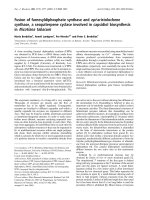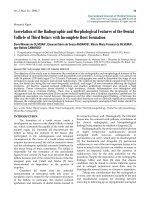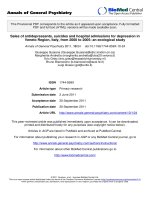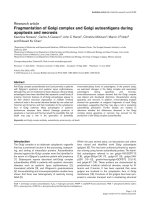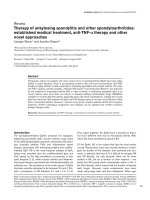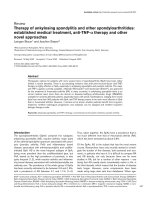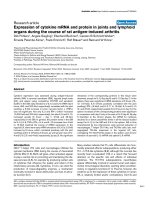Báo cáo y học: "ragmentation of Golgi complex and Golgi autoantigens during apoptosis and necrosis" ppt
Bạn đang xem bản rút gọn của tài liệu. Xem và tải ngay bản đầy đủ của tài liệu tại đây (1.14 MB, 9 trang )
Introduction
The Golgi complex is an elaborate cytoplasmic organelle
that has a prominent function in the processing, transport-
ing, and sorting of intracellular proteins. Autoantibodies
directed against the Golgi complex were first identified in
the serum of a Sjögren’s syndrome patient with lymphoma
[1]. Subsequent reports described anti-Golgi complex
autoantibodies (AGA) in patients with systemic rheumatic
diseases such as systemic lupus erythematosus [2],
rheumatoid arthritis [3], and Wegener’s granulomatosis
[4]. Immunoblotting and immunoprecipitation studies have
shown that there was heterogeneity of reactivity among
AGA [5].
Within the past several years, our laboratories and others
have cloned and identified novel Golgi autoantigens
(golgins) [6]. This has been achieved primarily by expres-
sion cloning using human autoantibody probes. The identi-
fied autoantigens referred to are golgin-160/GCP170
[7,8], golgin-95/gm130 [7], golgin-97 [9], golgin-245/
p230 [10–12], giantin/macrogolgin/GCP372 [13,14],
and golgin-67 [15]. These proteins are characterized by
predominant α-helical coiled-coil domains, except for N-
termini and C-termini. It has been reported that some
golgins are localized to the cytoplasmic face of Golgi
membranes [16]. Functions of the golgins have been pro-
posed in vesicular transport and in maintaining structural
AGA = anti-Golgi complex autoantibodies; H
2
O
2
= hydrogen peroxide; PARP = polyADP-ribose polymerase; PBS = phosphate-buffered saline;
STS = staurosporine; zVAD-fmk = benzylocarbonyl-Val-Ala-Asp-fluromethylketone.
Available online />Research article
Fragmentation of Golgi complex and Golgi autoantigens during
apoptosis and necrosis
Kazuhisa Nozawa
1
, Carlos A Casiano
2
, John C Hamel
1
, Christine Molinaro
2
, Marvin J Fritzler
3
and Edward KL Chan
1
1
Department of Molecular and Experimental Medicine, WM Keck Autoimmune Disease Center, The Scripps Research Institute, La Jolla,
California, USA
2
Department of Medicine and Department of Biochemistry and Microbiology, Center for Molecular Biology and Gene Therapy, Loma Linda
University School of Medicine, Loma Linda, California, USA
3
Department of Medicine and Department of Biochemistry and Molecular Biology, University of Calgary, Calgary, Alberta, Canada
Corresponding author: Edward KL Chan (e-mail: )
Received: 11 April 2002 Revisions received: 10 May 2002 Accepted: 10 May 2002 Published: 11 June 2002
Arthritis Res 2002, 4:R3
© 2002 Nozawa et al., licensee BioMed Central Ltd (Print ISSN 1465-9905; Online ISSN 1465-9913)
Abstract
Anti-Golgi complex autoantibodies are found primarily in patients
with Sjögren’s syndrome and systemic lupus erythematosus,
although they are not restricted to these diseases. Several Golgi
autoantigens have been identified that represent a small family of
proteins. Common features of all Golgi autoantigens appear to
be their distinct structural organization of multiple α-helical
coiled-coil rods in the central domains flanked by non-coiled-coil
N-termini and C-termini, and their localization to the cytoplasmic
face of Golgi cisternae. Many autoantigens in systemic
autoimmune diseases have distinct cleavage products in
apoptosis or necrosis and this has raised the possibility that cell
death may play a role in the generation of potentially
immunostimulatory forms of autoantigens. In the present study,
we examined changes in the Golgi complex and associated
autoantigens during apoptosis and necrosis.
Immunofluorescence analysis showed that the Golgi complex
was altered and developed distinctive characteristics during
apoptosis and necrosis. In addition, immunoblotting analysis
showed the generation of antigenic fragments of each Golgi
autoantigen, suggesting that they may play a role in sustaining
autoantibody production. Further studies are needed to
determine whether the differences observed in the Golgi
complex during apoptosis or necrosis may account for the
production of anti-Golgi complex autoantibodies.
Keywords: anti-Golgi complex antibody, autoantibody, autoimmunity, cell death
Page 1 of 9
(page number not for citation purposes)
Page 2 of 9
(page number not for citation purposes)
Arthritis Research Vol 4 No 4 Nozawa et al.
integrity of the Golgi complex [17–19]. The potential impli-
cation is that these Golgi proteins may have common bio-
chemical characteristics that may make them targets of
autoimmune responses in certain disease states.
It is not clear why and how the immune system is able to
recognize or target intracellular autoantigens. One possi-
ble explanation is that they may be recognized as surface
structures on cytoplasmic organelles that are released to
the immune system in aberrant disease states associated
with unregulated cell death (apoptosis or necrosis) result-
ing from injury or infection, or defective clearance of dying
cells. A variety of autoantigens are cleaved into signature
fragments during apoptosis and necrosis [20]. Other cell
death post-translational modifications in autoantigens
include hyperphosphorylation, (de)ubiquitination, methyla-
tion, citrullination, and transglutaminase crosslinking
[21,22].
The emerging view is that modified forms of autoantigens
generated during cell death might stimulate autoantibody
responses if presented to the immune system in a proin-
flammatory context [23]. Since the fate of the Golgi
complex during cell death has not been extensively
explored, we investigated whether the Golgi complex and
associated autoantigens are altered during apoptosis and
necrosis. Using AGA as probes, we observed that the
Golgi complex undergoes dynamic changes during apop-
tosis distinct from those observed in necrosis.
Immunoblotting analysis showed distinct cleavage frag-
ments of Golgi autoantigens generated during apoptosis
and necrosis. Since the cleaved Golgi autoantigen frag-
ments are antigenic, they may play a role in sustaining
autoantibody production in autoimmune disease states.
Materials and methods
Antibodies
Human prototype serum containing highly specific anti-
polyADP-ribose polymerase (PARP) antibody and AGA
sera were obtained from the serum bank of the WM Keck
Autoimmune Center, The Scripps Research Institute, CA,
USA. Rabbit antibodies to Golgi autoantigens were produced
in New Zealand White rabbits [7,9,10]. Briefly, recombi-
nant human Golgi autoantigens were produced using the
expression plasmid pET28 system in Escherichia coli
(Novagen, Madison, WI, USA). Recombinant golgin-160
(amino acids 787–1348, GenBank accession number
BAA23661), giantin (amino acids 851–1496, GenBank
accession number NP_004478), gm130 (amino acids
370–990, GenBank accession number AAF65550), and
golgin-97 (amino acids 1–767, GenBank accession
number AAB81549) proteins were purified by affinity
nickel column chromatography. They were then used to
immunize one or two rabbits separately by subcutaneous
injection of recombinant proteins in an equal volume of
Freund’s complete adjuvant. After booster immunizations,
the immune sera were prepared and stored at –20°C. The
appearance and titers of antibodies were monitored by
indirect immunofluorescence and immunoblotting analysis.
Induction of cell death
Human Jurkat and HEp-2 cells were obtained from Ameri-
can Type Culture Collection (Rockville, MD, USA) and
were cultured in RPMI 1640 and Dulbecco’s modified
Eagle’s medium (Life Technologies, Rockville, MD, USA),
respectively, containing 10% fetal bovine serum under
standard conditions. Induction of cell death was per-
formed essentially as described elsewhere [20] with some
modifications.
Apoptosis was induced in Jurkat T cells (10
6
/ml) by expo-
sure to 1 µM staurosporine (STS) (ALEXIS, San Diego,
CA, USA) for up to 4 hours. Apoptosis in HEp-2 cells was
induced by exposure to 2 µM STS at 37°C for up to
6 hours. Necrosis was induced in these cells by exposure
to 10 µM STS for up to 24 hours or by treatment with
0.1% hydrogen peroxide (H
2
O
2
) (Fisher Scientific, Pitts-
burgh, PA, USA) for 3 hours. Necrosis was quantified
using the trypan blue exclusion assay, which measures
loss of cytoplasmic membrane integrity, as described pre-
viously [20,24].
At least 300 cells were counted in triplicate in three inde-
pendent experiments. In some experiments, Jurkat cells
were incubated for 1 hour in the presence of the pan-
caspase inhibitor benzylocarbonyl-Val-Ala-Asp-fluromethyl-
ketone (zVAD-fmk) (ALEXIS), used at 100 µM, prior to
addition of STS. Treated and control cells, and their
extracts, were analyzed by indirect immunofluorescence
and/or immunoblotting analysis. Spontaneous cell death
prior to the experiments was minimized by maintaining
exponential cell growth. Cell viability was quantified by
trypan blue exclusion analysis at the beginning of every
experiment to ensure that cell cultures used in the experi-
ments were healthy (alive cells > 95%).
Indirect immunofluorescence microscopy
Indirect immunofluorescence was performed as reported
previously [7,10,25]. HEp-2 cells were grown on eight-
chamber vessel tissue culture slides (Becton Dickinson,
Franklin Lakes, NJ, USA) and treated with 2 or 10 µM STS
for up to 6 hours. Cells were fixed by methanol and
acetone (1:3, –20°C) for 2 min. Sera containing AGA
were used in dilutions of 1: 200 to 1:10,000. The sec-
ondary antibodies were Alexa™ 488 conjugated goat anti-
rabbit IgG or anti-human IgG reagents (ALEXIS). Cells
were counterstained with 4′,6-diamidino-2-phenylindole
nuclear stain prior to immunofluorescence microscopy.
The estimation of the percentage of cells at each morpho-
logical stage described in the following for Golgi staining
in apoptotic cells was obtained by scoring 300–500 cells
in each experiment.
Page 3 of 9
(page number not for citation purposes)
Immunoblotting analysis of cell lysates
After incubation in the presence of cell-death-inducing
reagents, Jurkat cells were centrifuged at 200 × g for
30 min, followed by one wash at 1000 × g for 10 min in
PBS containing Complete Protease Inhibitor cocktail
(Roche, Mannheim, Germany). Cell pellets (10
7
) were
then resuspended directly in lysis buffer containing
150 mM NaCl, 1 mM MgCl
2
·6H
2
O, 80 mM Tris–HCl and
0.1% NP-40.
The lysates were passed several times sequentially
through 18-gauge to 27-gauge needles to shear the DNA,
and protein concentrations in the lysates were determined
by Protein DC Assay Kit (Bio-Rad, Hercules, CA, USA) to
ensure equal loading of proteins in each SDS-PAGE lane.
After determination of the protein concentration, lysates
were mixed with an equal volume of 2 × gel sample buffer
containing 6% sodium dodecyl sulfate, 20% glycerol,
10% β-mercaptoethanol, 0.02% bromphenol blue and
Complete Protease Inhibitor cocktail. Lysates were stored
at –80°C until use.
The equivalent of 1.5 µg total lysate protein was loaded
onto each lane of 10% SDS-PAGE gels, separated by
electrophoresis, and transferred to nitrocellulose mem-
branes using a Semi-Dry Trans-Blot apparatus (Bio-Rad).
Immunoblotting was performed as described previously
[7,10,24] using human anti-PARP specific antibody
(1: 250) and AGA (1:250). Detection of bound antibodies
was achieved using horseradish peroxidase-conjugated
goat anti-human or anti-rabbit IgG antibody (CALTAG,
San Francisco, CA, USA), used at 1: 5000 dilution, in
combination with enhanced chemiluminescence (Super
Signal; PIERCE Products, Rockford, IL, USA).
Results
Induction of apoptosis and necrosis in HEp-2 cells
HEp-2 cells exposed to 2 and 10 µM STS exhibited apop-
totic-like fragmentation into multiple round bodies after
6 hours of treatment (Fig. 1c,d). Interestingly, cells
exposed to 10 µM STS showed a more pronounced loss
of cytoplasmic membrane integrity (Fig. 1e), indicating that
this STS concentration drove cell death more rapidly into
necrosis. As control, cells treated with levels of H
2
O
2
(0.1%) previously shown to provoke massive necrotic cell
death [20] exhibited a characteristic necrotic morphology
(Fig. 1b) associated with rapid loss of cytoplasmic mem-
brane (Fig. 1e).
Changes of the Golgi complex during apoptosis
Changes in the Golgi complex during apoptosis were
examined by immunostaining with AGA in HEp-2 cells
treated with 2 µM STS. Apoptosis was defined by stereo-
typic morphological changes, especially evident in the
nucleus, where the chromatin condenses and compacts,
and assumes a globular, crescent-shaped morphology
[26]. Figure 2 shows a composite of four apoptotic
stages, provisionally called stages I–IV (Fig. 2b–e), that
are classified on the basis of progression of apoptotic
nuclear change (middle panels) and corresponding stain-
ing for golgin-97 (left panels).
About 50–60% of cells appeared unaffected after 2 hours
of incubation in the presence of STS, as evidenced by
perinuclear Golgi staining identical to untreated cells
(Fig. 2a). Interestingly, ‘swelling’ of the Golgi complex with
vesicular staining (stage I) was observed in 10–20% of
cells, and is most strikingly demonstrated in Fig. 2b. It is
estimated that the area occupied by the swelled Golgi can
be ~5–10 times the normal size for Golgi complex in
HEp-2 cells. Slight changes in the shape of some nuclei
were observed, as shown in the middle panel, but most
cells with Golgi swelling exhibited no change in nuclear
size and shape.
About 10% of cells appeared to be in stage II (Fig. 2c)
where there was elongation of the nucleus, appearing
kidney or crescent shaped (middle panel). A characteristic
of stage II was that the Golgi complex was condensed at
the concave or indented region of the crescentic nucleus
(right panel). Stage III (Fig. 2d) was seen in 3–5% of cells
with defined nuclear fragmentation into two approximately
equal fragments (middle panel) and golgin-97 primarily
located at the cleavage zone between the two nuclear
fragments (right panel). About 10–15% of the cells were
considered to be at stage IV (Fig. 2e), where their nuclei
were fragmented into more than two pieces (middle panel)
and golgin-97 staining appeared as vesicular structures.
This was the final stage when remnants of the Golgi
complex could be detected.
Evaluation of cells after 6 hours of incubation with 2 µM
STS showed all four stages described (data not shown).
At this time, up to 50% of cells were in stage I, 20% were
in stage II, 2–3% were in stage III, and 25% of cells were
in stage IV. These data suggested that STS-treated cells
do not enter the apoptotic pathway at the same time,
which is consistent with the notion that apoptosis is a rela-
tively asynchronous process.
Similar staining patterns to those seen with golgin-97
were observed when apoptotic HEp-2 cells were stained
with antibodies to golgin-95, golgin-160, golgin-245, and
giantin (data not shown). These results were also repro-
duced in HeLa S3 and mouse J774A.1 cells treated with
2 µM STS (data not shown). The amount of Golgi swelling
observed in stage I varied in different experiments, but the
characteristics for stages II–IV were highly reproducible in
all the experiments we have conducted. Our observations
of Golgi swelling during apoptosis are supported by previ-
ous studies. For instance, in neurons undergoing apopto-
sis, morphologic changes were characterized by a highly
Available online />ordered sequence of organelle abnormalities, with
swelling of endoplasmic reticulum and Golgi vesiculation
that preceded most nuclear changes or mitochondrial
disruption [27,28].
Changes of the Golgi complex during necrosis
In contrast to the Golgi swelling already described, strik-
ing fragmentation of the Golgi complex was observed
during necrosis in HEp-2 cells treated with 10 µM STS
(Fig. 2f). As shown in Fig. 1b,e, approximately 50% of cells
treated with this STS concentration, while initially showing
apoptotic-like fragmentation into multiple bodies, gradually
died by necrosis. Figure 2f shows Golgi fragments clearly
visible (arrows) in cells with condensed nuclei after
6 hours of treatment with 10 µM STS. Note the absence
of nuclear fragmentation in these cells compared with
Arthritis Research Vol 4 No 4 Nozawa et al.
Page 4 of 9
(page number not for citation purposes)
Figure 1
Morphology of HEp-2 cells. (a) Untreated HEp-2 cells, and HEp-2 cells after 6 hours of exposure to (b) hydrogen peroxide (H
2
O
2
), (c) 2 µM
staurosporine (STS), and (d) 10 µM STS. Images were acquired using an Olympus IX-70 microscope equipped with Hoffman modulation contrast.
(e) Time-dependent loss of HEp-2 cytoplasmic membrane integrity in control cells (open circles) and cells exposed to 0.1% H
2
O
2
(triangles), to
2 µM STS (diamonds), and to 10 µM STS (squares). The loss of cytoplasmic membrane integrity, indicative of necrosis, was quantified using the
trypan blue exclusion assay. Values are the mean ± standard deviation from three independent experiments.
apoptotic cells (Fig. 2e), consistent with previous observa-
tions showing that necrotic nuclei exhibit condensation
but not fragmentation [20]. In this treatment, designed to
drive apoptotic cells more rapidly into necrosis, changes
in the Golgi complex similar to the four stages observed in
apoptosis were not detected. Similar results were also
obtained for other Golgi autoantigens, including golgin-
160, giantin, and golgin-95 (data not shown).
No Golgi staining was observed in HEp-2 cells treated
with 10 µM STS for 24 hours or with 0.1% H
2
O
2
(data not
shown), presumably due to the extensive cytoplasmic
damage associated with necrosis. These results sug-
gested that the Golgi complex is affected differently in
apoptosis and in necrosis, prompting us to examine
whether specific Golgi proteins are targeted for proteo-
lysis in these modes of cell death.
Golgi autoantigens are cleaved during apoptosis and
necrosis
It is well established that specific intracellular auto-
antigens are cleaved into different fragments in Jurkat
T cells and other cell types undergoing apoptosis and
necrosis [20]. Mancini et al. reported that golgin-160
(native protein, 160 kDa) was cleaved into a 140 kDa frag-
ment during apoptosis [29]. We therefore performed an
immunoblotting analysis using extracts from Jurkat cells
treated with apoptosis-inducing reagent (1 µM STS) or
necrosis-inducing reagent (0.1% H
2
O
2
) to investigate
whether Golgi autoantigens are cleaved in the two major
types of cell death. PARP (110 kDa protein) was selected
as a positive control to monitor the cleavage of proteins
during apoptosis and necrosis because its cleavage prod-
ucts in Jurkat cells undergoing apoptosis (89 kDa) and
undergoing necrosis (60 and 50 kDa) are well established
[20,24,30].
Figure 3 shows the results of immunoblotting analysis
using antibodies to PARP and four Golgi autoantigens. In
cells treated with STS (Fig. 3, left) or H
2
O
2
(Fig. 3, right),
PARP was cleaved into an 89 kDa polypeptide (apoptotic
fragments) or 60 and 50 kDa polypeptides (necrotic frag-
ments), respectively, with complete degradation of native
protein as previously described [24]. Golgin-160 was
cleaved into 140 and 80 kDa fragments in apoptotic cells,
consistent with published observations [29]. In contrast to
the apoptotic fragments, a 70 kDa fragment was detected
in necrotic cells. Giantin was cleaved into three major
Available online />Page 5 of 9
(page number not for citation purposes)
Figure 2
Changes of the Golgi complex during apoptosis and necrosis induced by staurosporine (STS). (a) Untreated HEp-2 cell control, and (b)–(e) cells
treated with 2 µM STS for up to 6 hours for the induction of apoptosis. Apoptotic cells can be classified into four basic stages based on the
nuclear change and the staining of Golgi antigens. (b) Stage I represents Golgi swelling (double-head arrows) that appears at an early stage when
distinctive changes are seen in the shape of the nucleus (arrow). The area occupied by the swelled Golgi can be ~5–10 times the normal size for
the Golgi complex in HEp-2 cells. (c) Stage II shows the characteristic condensation of the Golgi complex adjacent to the nucleus that was
elongated and appeared as a kidney shape or a crescent shape (arrow). (d) Stage III is seen in cells with defined nuclear fragmentation into two
approximately equal nuclear fragments, and immunostaining of the Golgi antigen was primarily located at the cleavage site between the two nuclear
fragments. (e) In stage IV, nuclei were fragmented into multiple fragments with smaller pieces (middle panel, arrows) and Golgi staining appeared
as vesicular structures. (f) HEp-2 cells 6 hours after treatment of 10 µM STS for the induction of necrosis. In contrast to apoptosis, striking
fragmentation of the Golgi complex was observed with nuclear condensation rather than nuclear fragmentation. Immunostaining was performed
using rabbit anti-golgin-97 and Alexa™ 488 conjugated goat anti-rabbit IgG antibody (left panels), and the nuclei were counterstained by 4′,6-
diamidino-2-phenylindole (DAPI) (middle panels). Right panels show the merged images. AGA, anti-Golgi complex autoantibodies.
apoptotic fragments (150, 80, and 60 kDa), and these
fragments were clearly different from the 75 and 50 kDa
fragments derived from necrosis. Interestingly, while apop-
totic fragments of golgin-95 and golgin-97 were not
detected, necrotic fragments at 50 and 70 kDa were
detected for both proteins. A summary of the Golgi protein
fragments generated during apoptosis and necrosis is
presented in Table 1.
Arthritis Research Vol 4 No 4 Nozawa et al.
Page 6 of 9
(page number not for citation purposes)
Figure 3
Immunoblot analysis of cleavage fragments of Golgi autoantigens
(panels b–e) and polyADP-ribose polymerase (PARP, panel a) during
apoptotic and necrotic cell death. Jurkat cells were exposed to either
1 µM staurosporine (STS) for 2 or 4 hours (left) or 0.1% hydrogen
peroxide (H
2
O
2
) for 3 hours (right) for the induction of apoptosis and
necrosis, respectively. Intact protein and cleavage fragments are
indicated. Numbers to left of each blot represent the relative molecular
weight (kDa). Note that the 75 kDa band detected by anti-golgin-95 in
the control as well as the sample treated with STS for 2 hours may
represent an unrelated protein recognized by the antiserum. Also note
that this 75 kDa protein was not detected in HEp-2 cells. g160, golgin-
160; g97, golgin-97; gm130, golgin-95.
Figure 4
Apoptotic cleavage of Golgi autoantigens is caspase dependent.
Benzylocarbonyl-Val-Ala-Asp-fluromethylketone (zVAD-fmk) (100 µM)
was added to Jurkat cells 1 hour prior to addition of staurosporine
(STS). Cells were then exposed to STS for 4 hours prior to harvest for
lysate preparation. Representative blots of lysates from untreated
control, 1 µM STS treatment without zVAD-fmk, and 1 µM STS
treatment with zVAD-fmk are shown. Intact protein and cleavage
fragments are indicated. Numbers to left of each blot represent the
relative molecular weight (kDa). g160, golgin-160; g97, golgin-97;
gm130, golgin-95; PARP, polyADP-ribose polymerase. See Figure 3
for explanation of a–e.
Proteolysis of Golgi autoantigens induced by apoptosis
is caspase dependent
The caspase family of proteases plays a central role in
apoptosis by participating in a cascade of cleavage events
that result in the apoptotic phenotype [31]. We investi-
gated whether the proteolysis of Golgi autoantigens
caused by treatment with STS was caspase dependent.
Jurkat cells were treated with 1 µM STS for 4 hours after
preincubation with the pan-caspase inhibitor 100 µM
zVAD-fmk. The generation of proteolytic fragments from
Golgi autoantigens was completely blocked in Jurkat cells
pretreated with zVAD-fmk (Fig. 4), indicating that cleavage
of Golgi autoantigens during apoptosis is mediated by
caspases.
Discussion
Apoptotic changes of the Golgi complex
Lane et al. reported recently that the Golgi complex in
HeLa cells is fragmented into scattered vesicles by cas-
pases due to interference of Golgi reassembly and abnor-
malities of the 65 kDa stacking protein GRASP65 [32]. In
the present report, we describe characteristic changes of
the Golgi complex during the progression of apoptosis. It
is not known whether the Golgi complex functions as a
stress sensor involved in the regulation of apoptosis.
Mancini et al. reported that caspase-2 was localized at the
Golgi complex and generated a unique cleavage product
of golgin-160 [29]. Furthermore, these investigators pro-
posed that the Golgi complex transduces proapoptotic
signals [29]. A precedent for this hypothesis was provided
by Nakagawa et al., who reported that caspase-12 is
localized to the endoplasmic reticulum and mediates an
endoplasmic reticulum-specific apoptosis pathway [33]. In
the present study, we have found that all Golgi autoanti-
gens examined were cleaved in apoptosis in a caspase-
dependent manner, as evidenced by studies showing that
the pan-caspase inhibitor zVAD-fmk completely blocked
the apoptotic fragmentation of these antigens. Although
the requirement for specific caspases was not examined
here, it is possible that caspases localized in the Golgi
complex (including caspase-2) transduce death signals
during the early stages of apoptosis that are associated
with fragmentation of specific Golgi proteins.
It has been reported that apoptotic death receptors such
as CD95 [34], tumor necrosis factor-related apoptosis
inducing ligand receptor 1, tumor necrosis factor-related
apoptosis inducing ligand receptor 2 [35], and tumor
necrosis factor receptor 1 [36] are enriched in the Golgi
complex prior to transport to the plasma membrane, thus
suggesting that the Golgi complex may play an important
role in apoptotic signalling. We now provide evidence for
characteristic alterations in the Golgi complex correspond-
ing to nuclear change during the progression of apoptosis.
Swelling of the Golgi complex was particularly detected in
the early stages of apoptosis. It could be speculated that
apoptotic alterations of the Golgi complex may facilitate
the transportation of death receptors from the Golgi
complex to the plasma membrane, and may amplify the
apoptotic events once apoptosis was initiated. Additional
studies are needed to examine the precise function of the
Golgi complex during apoptosis.
Role of apoptotic or necrotic fragments in autoantibody
production
Analysis of post-translational modifications in intracellular
autoantigens associated with apoptosis and necrosis
should provide important insights into the possible role of
cell death in the generation of potentially autoantigenic
forms of cellular antigens. Casciola-Rosen and coworkers
have proposed that modifications of autoantigens during
cell death, particularly proteolytic cleavage, might be
crucial for the generation of autoantibodies in autoimmune
diseases [23,37]. Unique proteolytic fragments of α-fodrin
and type 3 muscarinic acetylcholine receptor have been
implicated in the generation of autoantibody responses in
primary Sjögren’s syndrome [38,39].
Although direct evidence that autoantigen cleavage frag-
ments produced during cell death elicit autoantibody
responses is still scarce, Pollard et al. reported that immu-
nization of B10.S mice (H-2
s
) with a 19 kDa proteolytic
cleavage fragment of fibrillarin (derived from nonapoptotic
cell death) elicited antibodies that are comparable with
human anti-fibrillarin autoantibodies and those derived from
mice exposed to mercury [40]. In a study using human sera,
Greidinger et al. reported that the recognition of apoptosis-
derived and oxidatively modified forms of the 70 kDa
subunit of U1 small nuclear ribonucleoprotein autoantigen
was associated with distinct disease manifestations [41].
Furthermore, Oriss et al. demonstrated that a combination
of antigen-processing cells and a fragment of DNA topoiso-
merase I efficiently elicited autoreactive T-cell proliferation,
whereas the full-length topoisomerase I required additional
stimulus of exogenous interleukin-2 [42].
Available online />Page 7 of 9
(page number not for citation purposes)
Table 1
Fragmentation of Golgi autoantigens during apoptosis and
necrosis in Jurkat cells
Molecular Major Major
weight apoptotic necrotic
Golgi of intact fragments fragments
antigens protein (kDa) (kDa) (kDa)
Giantin 370 80, 60 75, 50
Golgin-160 160 140, 80 70
Golgin-95 130 None 50
Golgin-97 97 None 70
Cleavage fragments were detected by immunoblotting of apoptotic
and necrotic lysates.
These data point to a crucial role for fragments of autoanti-
gens in the generation of autoantibody responses. In the
present study, several Golgi autoantigens were detected
cleaved into distinctive fragments during apoptosis and
necrosis. It has been speculated that these modified forms
of autoantigens may have enhanced immunogenicity
through exposure of immunocryptic epitopes that are not
generated during antigen processing [21,23,37,43].
These epitopes could trigger autoimmune responses if
presented to the immune system under proinflammatory
conditions [44], and they may be recognized as surface
structures on cytoplasmic organelles that are released to
the immune system in aberrant disease states.
Autoantibody responses could be amplified and main-
tained on repeated stimulation if the exposure of intra-
cellular antigens to the immune system is associated
with defective clearance of apoptotic cells, prolonged
necrosis (primary or secondary), T-cell cytotoxicity asso-
ciated with chronic infection, or even antigen mutation
or overexpression. It would be important not only to
assess the immunogenic potential of subcellular parti-
cles and proteolytic fragments released during cell
death, but also to continue investigating possible
defects leading to aberrant apoptosis or phagocyte
function and/or aberrant antigen expression in systemic
autoimmune diseases.
Kinetics of degradation of golgins and generation of
apoptotic fragments
Although only well-defined apoptotic fragments of
golgin-160 and giantin, not of golgin-95 and golgin-97,
were detected after 2 or 4 hours of incubation with STS,
total disappearance of intact proteins was detected with
all Golgi autoantigens and complete blockage was
observed in the presence of z-VAD-fmk. These results
suggested that there might be differences in the kinetics
of degradation among the golgins, with golgin-95 and
golgin-97 perhaps being more sensitive to proteolysis
and being targeted very early during apoptosis. While
the absence of apoptotic fragments for golgin-95 and
golgin-97 suggests that total degradation of these pro-
teins occurred without generation of intermediate pro-
tease-resistant fragments, it cannot be ruled out that the
intact proteins were released from apoptotic cells or that
their apoptotic fragments were not recognized by
autoantibodies.
In the present study, Jurkat cells were relatively sensitive
to the treatment with STS such that the kinetics of degra-
dation of different golgins relative to that of PARP could
not be accurately differentiated. Since HEp-2 cells grown
as a monolayer were observed to be more resistant to
apoptosis compared with Jurkat cells, we used HEp-2
cells to investigate more precisely the relative kinetics of
degradation for the native golgins during apoptosis.
An identical pattern of fragmentation was essentially
observed for all the Golgi autoantigens examined except
that the overall kinetics of native protein degradation was
slower (data not shown). The integrity of native golgin-95
and golgin-97, in which apoptotic fragments were not
detected, was almost completely maintained at 12 hours
after the addition of STS (data not shown). In contrast,
native golgin-160 and giantin were degraded into their
respective fragments 12 hours after the addition of STS.
The processing of golgin-160 and giantin occurred as
early as that for PARP, suggesting that these proteins are
cleaved during the onset of apoptosis (data not shown).
Cleavage of golgin-160 and giantin may thus play a poten-
tially important role in the early stages of apoptosis.
Although we did not determine which golgins are sub-
strates for specific caspases, further studies aimed at
defining the caspases responsible for golgin cleavage, the
cleavage sites, and the biological consequences of these
cleavages should provide important insights into the pos-
sible role of some of the Golgi autoantigens in apoptosis.
Conclusion
The present study has shown overall morphologic
changes of the Golgi complex during apoptosis and
necrosis, with distinct fragmentation patterns of its associ-
ated autoantigens. We propose that cleavage of golgin-
160 and giantin may play a role in early events in
apoptosis. We also speculate that Golgi fragmentation in
cell death might participate in sustaining autoantibody
response to the Golgi complex in aberrant disease states
characterized by unregulated cell death resulting from
injury or infection or defective clearance of dying cells.
Acknowledgments
The present study is publication 14756-MEM from The Scripps
Research Institute. This work was supported in part by National Insti-
tutes of Health Grants AI39645 and AI47859 (EKLC), AI44088
(CAC), Canadian Institutes for Health Research Grant MOP-38034
(MJF), and the Sam and Rose Stein Charitable Trust.
References
1. Rodriguez JL, Gelpi C, Thomson TM, Real FJ, Fernandez J: Anti-
Golgi complex autoantibodies in a patient with Sjögren syn-
drome and lymphoma. Clin Exp Immunol 1982, 49:579-586.
2. Fritzler MJ, Etherington J, Sokoluk C, Kinsella TD, Valencia DW:
Antibodies from patients with autoimmune disease react with
a cytoplasmic antigen in the Golgi apparatus. J Immunol 1984,
132:2904-2908.
3. Hong HS, Morshed SA, Tanaka S, Fujiwara T, Ikehara Y, Nishioka
M: Anti-Golgi antibody in rheumatoid arthritis patients recog-
nizes a novel antigen of 79 kDa (doublet) by western blot.
Scand J Immunol 1992, 36:785-792.
4. Mayet WJ, Hermann E, Csernok E, Knuth A, Poralla T, Gross WL,
Meyer zum Buschenfelde KH: A human renal cancer line as a
new antigen source for the detection of antibodies to cyto-
plasmic and nuclear antigens in sera of patients with Wegen-
er’s granulomatosis. J Immunol Methods 1991, 143:57-68.
5. Kooy J, Toh BH, Gleeson PA: Heterogeneity of human anti-
Golgi auto-antibodies: reactivity with components from 35 to
260 kDa. Immunol Cell Biol 1994, 72:123-127.
6. Chan EKL, Fritzler MJ: Golgins: coiled-coil proteins associated
with the Golgi Complex. Electron J Biotechnol 1998, 1:1-10.
Arthritis Research Vol 4 No 4 Nozawa et al.
Page 8 of 9
(page number not for citation purposes)
7. Fritzler MJ, Hamel JC, Ochs RL, Chan EKL: Molecular characteri-
zation of two human autoantigens: Unique cDNAs encoding
95- and 160-kD proteins of a putative family in the Golgi
complex. J Exp Med 1993, 178:49-62.
8. Misumi Y, Sohda M, Yano A, Fujiwara T, Ikehara Y: Molecular
characterization of GCP170, a 170-kDa protein associated
with the cytoplasmic face of the Golgi membrane. J Biol Chem
1997, 272:23851-23858.
9. Griffith KJ, Chan EKL, Lung CC, Hamel JC, Guo X, Miyachi K, Frit-
zler MJ: Molecular cloning of a novel 97-kd Golgi complex
autoantigen associated with Sjögren’s syndrome. Arthritis
Rheum 1997, 40:1693-1702.
10. Fritzler MJ, Lung CC, Hamel JC, Griffith K, Chan EKL: Molecular
characterization of golgin-245: a novel Golgi complex protein
containing a granin signature. J Biol Chem 1995, 270:31262-
31268.
11. Erlich R, Gleeson PA, Campbell P, Dietzsch E, Toh BH: Molecu-
lar characterization of trans-Golgi p230. A human peripheral
membrane protein encoded by a gene on chromosome 6p12-
22 contains extensive coiled-coil alpha-helical domains and a
granin motif. J Biol Chem 1996, 271:8328-8337.
12. Kooy J, Toh BH, Pettitt JM, Erlich R, Gleeson PA: Human auto-
antibodies as reagents to conserved Golgi components.
Characterization of a peripheral, 230-kDa compartment-
specific Golgi protein. J Biol Chem 1992, 267:20255-20263.
13. Sohda M, Misumi Y, Fujiwara T, Nishioka M, Ikehara Y: Molecular
cloning and sequence analysis of a human 372-kDA protein
localized in the Golgi complex. Biochem Biophys Res Commun
1994, 205:1399-1408.
14. Seelig HP, Schranz P, Schroter H, Wiemann C, Renz M: Macro-
golgin—a new 376 kD Golgi complex outer membrane protein
as target of antibodies in patients with rheumatic diseases
and HIV infections. J Autoimmun 1994, 7:67-91.
15. Eystathioy T, Jakymiw A, Fujita DJ, Fritzler MJ, Chan EKL: Human
autoantibodies to a novel Golgi protein golgin-67: high simi-
larity with golgin-95/gm 130 autoantigen. J Autoimmun 2000,
14:179-187.
16. Munro S, Nichols BJ: The GRIP domain—a novel Golgi-target-
ing domain found in several coiled-coil proteins. Curr Biol
1999, 9:377-380.
17. Orci L, Stamnes M, Ravazzola M, Amherdt M, Perrelet A, Sollner
TH, Rothman JE: Bidirectional transport by distinct populations
of COPI-coated vesicles. Cell 1997, 90:335-349.
18. Orci L, Perrelet A, Rothman JE: Vesicles on strings: morpholog-
ical evidence for processive transport within the golgi stack.
Proc Natl Acad Sci USA 1998, 95:2279-2283.
19. Sonnichsen B, Lowe M, Levine T, Jamsa E, Dirac-Svejstrup B,
Warren G: A role for giantin in docking COPI vesicles to Golgi
membranes. J Cell Biol 1998, 140:1013-1021.
20. Casiano CA, Ochs RL, Tan EM: Distinct cleavage products of
nuclear proteins in apoptosis and necrosis revealed by
autoantibody probes. Cell Death Differ 1998, 5:183-190.
21. Utz PJ, Anderson P: Posttranslational protein modifications,
apoptosis, and the bypass of tolerance to autoantigens.
Arthritis Rheum 1998, 41:1152-1160.
22. van Venrooij WJ, Pruijn GJ: Citrullination: a small change for a
protein with great consequences for rheumatoid arthritis.
Arthritis Res 2000, 2:249-251.
23. Casciola-Rosen L, Andrade F, Ulanet D, Wong WB, Rosen A:
Cleavage by granzyme B is strongly predictive of autoantigen
status: implications for initiation of autoimmunity. J Exp Med
1999, 190:815-826.
24. Wu X, Molinaro C, Johnson N, Casiano CA: Secondary necrosis
is a source of proteolytically modified forms of specific intra-
cellular autoantigens: implications for systemic autoimmunity.
Arthritis Rheum 2001, 44:2642-2652.
25. Andrade LEC, Chan EKL, Peebles CL, Tan EM: Two major
autoantigen-antibody systems of the mitotic spindle appara-
tus. Arthritis Rheum 1996, 39:1643-1653.
26. Leist M, Jaattela M: Four deaths and a funeral: from caspases to
alternative mechanisms. Nat Rev Mol Cell Biol 2001, 2:589-598.
27. Smith RG, Siklos L, Alexianu ME, Engelhardt JI, Mosier DR, Colom
L, Habib Mohamed A, Appel SH: Autoimmunity and ALS.
Neurology 1996, 47:40-45.
28. Portera-Cailliau C, Price DL, Martin LJ: Excitotoxic neuronal
death in the immature brain is an apoptosis–necrosis mor-
phological continuum. J Comp Neurol 1997, 378:70-87.
29. Mancini M, Machamer CE, Roy S, Nicholson DW, Thornberry NA,
Casciola-Rosen LA, Rosen A: Caspase-2 is localized at the
Golgi complex and cleaves golgin-160 during apoptosis.
J Cell Biol 2000, 149:603-612.
30. Gobeil S, Boucher CC, Nadeau D, Poirier GG: Characterization
of the necrotic cleavage of poly(ADP-ribose) polymerase
(PARP-1): implication of lysosomal proteases. Cell Death
Differ 2001, 8:588-594.
31. Creagh EM, Martin SJ: Caspases: cellular demolition experts.
Biochem Soc Trans 2001, 29:696-702.
32. Lane JD, Lucocq J, Pryde J, Barr FA, Woodman PG, Allan VJ,
Lowe M: Caspase-mediated cleavage of the stacking protein
GRASP65 is required for Golgi fragmentation during apopto-
sis. J Cell Biol 2002, 156:495-509.
33. Nakagawa T, Zhu H, Morishima N, Li E, Xu J, Yankner BA, Yuan J:
Caspase-12 mediates endoplasmic-reticulum-specific apop-
tosis and cytotoxicity by amyloid-beta. Nature 2000, 403:98-
103.
34. Bennett M, Macdonald K, Chan SW, Luzio JP, Simari R,
Weissberg P: Cell surface trafficking of Fas: a rapid mecha-
nism of p53-mediated apoptosis. Science 1998, 282:290-293.
35. Zhang XD, Franco AV, Nguyen T, Gray CP, Hersey P: Differential
localization and regulation of death and decoy receptors for
TNF-related apoptosis-inducing ligand (TRAIL) in human
melanoma cells. J Immunol 2000, 164:3961-3970.
36. Jones SJ, Ledgerwood EC, Prins JB, Galbraith J, Johnson DR,
Pober JS, Bradley JR: TNF recruits TRADD to the plasma mem-
brane but not the trans-Golgi network, the principal subcellu-
lar location of TNF-R1. J Immunol 1999, 162:1042-1048.
37. Andrade F, Roy S, Nicholson D, Thornberry N, Rosen A, Casciola-
Rosen L: Granzyme B directly and efficiently cleaves several
downstream caspase substrates: implications for CTL-
induced apoptosis. Immunity 1998, 8:451-460.
38. Haneji N, Nakamura T, Takio K, Yanagi K, Higashiyama H, Saito I,
Noji S, Sugino H, Hayashi Y: Identification of alpha-fodrin as a
candidate autoantigen in primary Sjögren’s syndrome.
Science 1997, 276:604-607.
39. Nagaraju K, Cox A, Casciola-Rosen L, Rosen A: Novel fragments
of the Sjogren’s syndrome autoantigens alpha-fodrin and
type 3 muscarinic acetylcholine receptor generated during
cytotoxic lymphocyte granule-induced cell death. Arthritis
Rheum 2001, 44:2376-2386.
40. Pollard KM, Pearson DL, Bluthner M, Tan EM: Proteolytic cleav-
age of a self-antigen following xenobiotic-induced cell death
produces a fragment with novel immunogenic properties.
J Immunol 2000, 165:2263-2270.
41. Greidinger EL, Casciola-Rosen L, Morris SM, Hoffman RW,
Rosen A: Autoantibody recognition of distinctly modified
forms of the U1-70-kd antigen is associated with different
clinical disease manifestations. Arthritis Rheum 2000, 43:881-
888.
42. Oriss TB, Hu PQ, Wright TM: Distinct autoreactive T cell
responses to native and fragmented DNA topoisomerase I:
influence of APC type and IL-2. J Immunol 2001, 166:5456-
5463.
43. Casciola-Rosen LA, Anhalt GJ, Rosen A: DNA-dependent
protein kinase is one of a subset of autoantigens specifically
cleaved early during apoptosis. J Exp Med 1995, 182:1625-
1634.
44. Rovere P, Sabbadini MG, Fazzini F, Bondanza A, Zimmermann
VS, Rugarli C, Manfredi AA: Remnants of suicidal cells foster-
ing systemic autoaggression. Apoptosis in the origin and
maintenance of autoimmunity. Arthritis Rheum 2000, 43:1663-
1672.
Correspondence
Edward KL Chan, PhD, Department of Molecular and Experimental
Medicine, The Scripps Research Institute, 10550 North Torrey Pines
Road, La Jolla, CA 92037, USA. Tel: +1 858 784 8250; fax: +1 858
784 2129; e-mail:
Available online />Page 9 of 9
(page number not for citation purposes)



